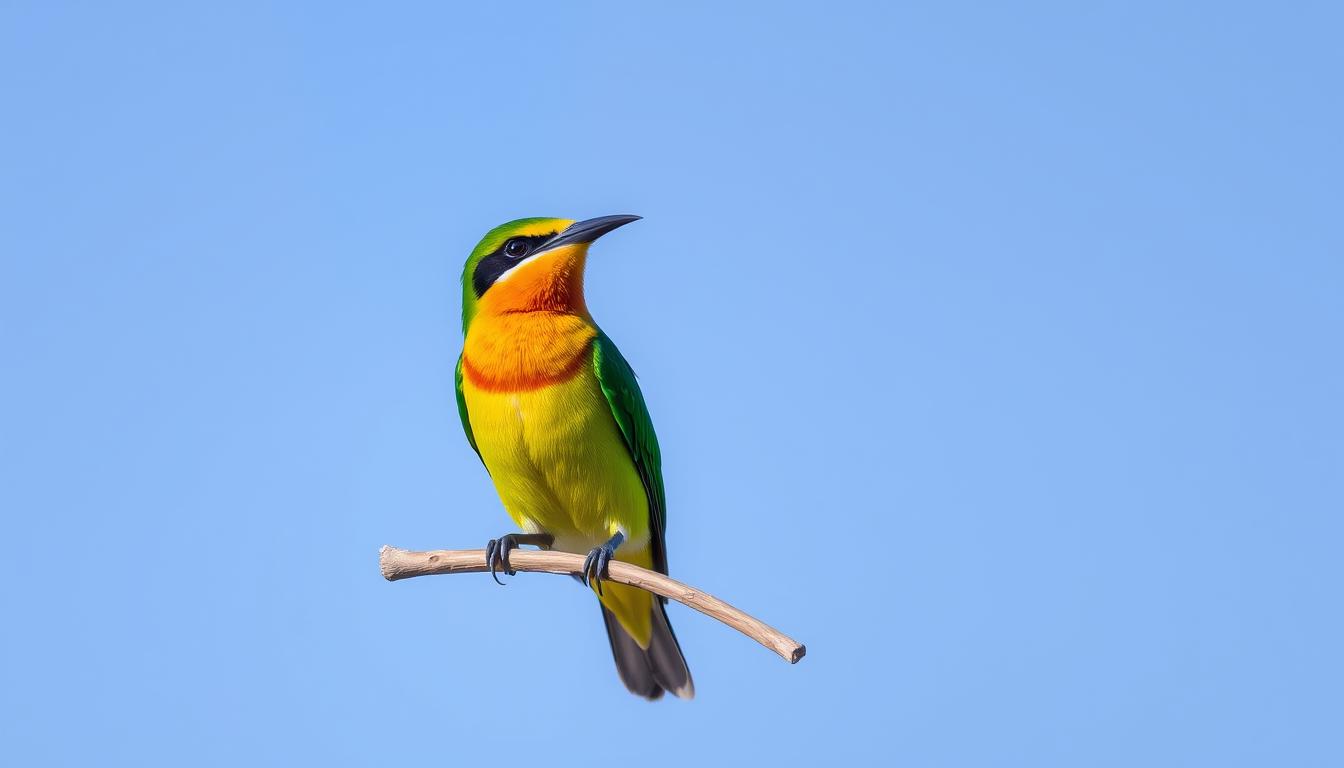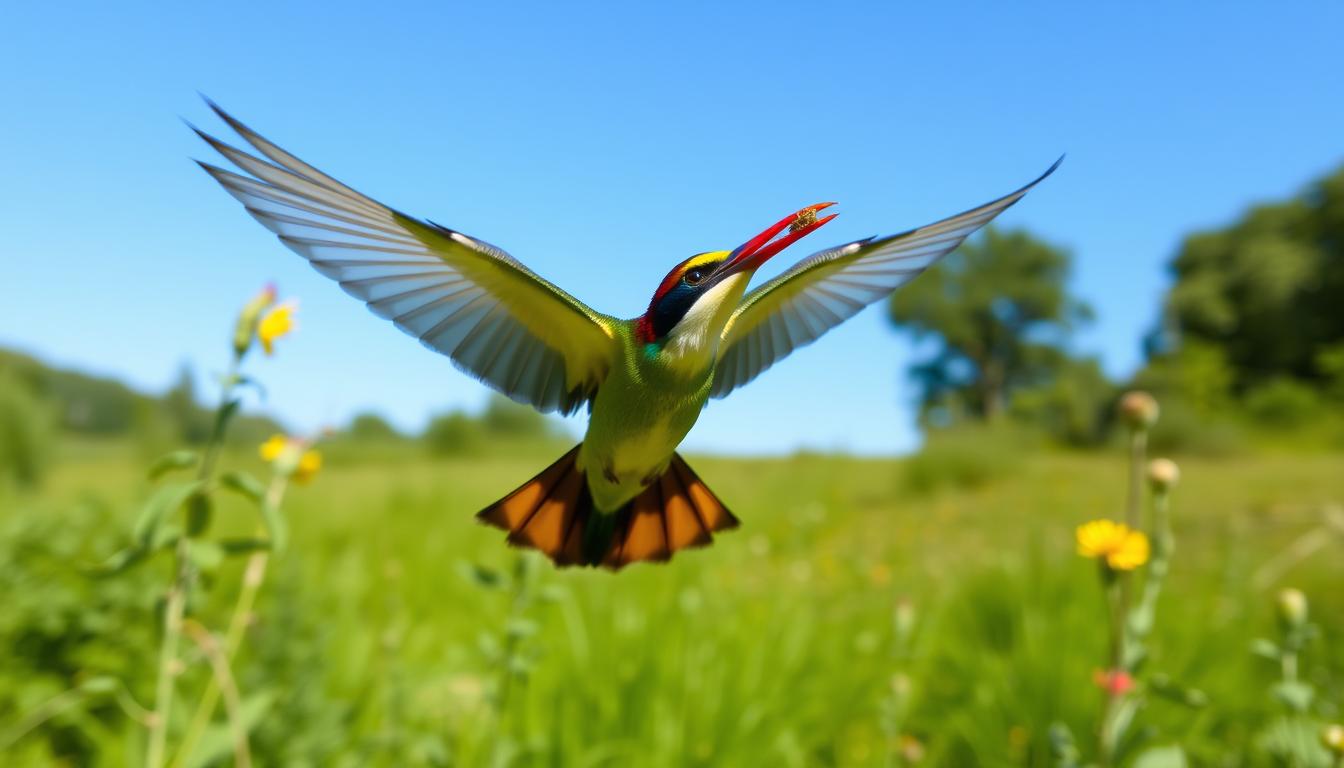European Bee-Eater (Merops apiaster)
Did you know the European Bee-Eater eats up to 250 bees a day? This bird is not only colourful but also helps control insects. Let’s explore the European Bee-Eater, or Merops apiaster, and its role in nature.
This bird is found in southern and central Europe, Africa, and western Asia. It’s a species that’s not worried about being endangered. Bird watchers and ecologists love it for its ability to thrive in different places.
Introduction to the European Bee-Eater
The European Bee-Eater, known as Merops apiaster, is a bird with bright colours and interesting behaviours. It is often seen perched on branches. The family Meropidae has 27 species, of which the European Bee-Eater is the most common, often seen in groups of 20 to 100 birds.
These birds are loved by birdwatchers and nature lovers. Their social nature and bright looks make them stand out.
Overview of the Species
The European Bee-Eater migrates between Eurasia and southern Africa, leaving in mid-August to early October. During the day, they fly high in groups and often return to their perch after feeding.
There are about 20,000 breeding birds in southern Africa. They nest from September to January, usually in groups. They lay four to six eggs in a burrow, which they excavate in sandy banks.
In places like the Isle of Wight, they breed well. This shows how adaptable they are.
Importance in Ecosystem
The European Bee-Eater is more than just a pretty bird. It eats flying insects like bees and wasps, helping to balance the ecosystem.
By eating moths, butterflies, and grasshoppers, they help biodiversity. Their unique ways of eating and living show how important they are. They help keep the ecosystem healthy.
| Species | Breeding Population | Clutch Size | Migration Timing |
|---|---|---|---|
| European Bee-Eater (Merops apiaster) | ~20,000 (Southern Africa) | 4-6 eggs | Mid-August to Early October |
| Ecological Role | Insect Control | Colonial Nesters | Breeding September to January |
Physical Characteristics of Merops apiaster
The European Bee-Eater is a bird that catches the eye. Its bright colors and size make it a joy to watch. Bird lovers find it especially beautiful.
Colouration and Size
The European Bee-Eater’s colours are amazing. It has brown and yellow on top, green wings, and a black beak, which helps it blend in and stand out.
These birds are 27 to 30 cm long and have long tail feathers that make them elegant. Males and females look similar, but females have greener shoulders.
Distinctive Features
This bird is known for its bright colours and social nature. It’s often seen with friends. Its long wings and tail feathers make it fly beautifully.
When it’s not breeding, its colours fade a bit. This shows how it can adapt to different places. Its unique looks help it fit into its environment.

Migration Patterns and Habitats
The European Bee-Eater’s migration patterns and habitats are quite interesting. During the breeding season, these birds live in southern and central Europe. They move frequently to find good places to nest and eat.
Breeding Range and Seasonal Movements
The European Bee-Eater breeds in northern and southern Africa and western Asia. It migrates long distances every year. Birds from the Iberian Peninsula to Germany go to Morocco’s Atlantic coast for winter.
Those from eastern areas like Russia and Kazakhstan migrate through the Black Sea and Caspian Sea. During migration, they end up in East and Southern Africa, as well as North Africa.
These birds are very loyal to their breeding sites, often returning to the same burrow year after year. Over 80% return to the same place every year. This shows they like to stay close to where they were born.
Preferred Habitats and Nesting Sites
European Bee-Eaters like certain places to live. They nest in undercut river slopes, wadis, and natural loess walls. But, they also nest in vineyards and rural areas in Europe.
In Hungary, 28% of adults return to their colonies. They often pick places near people’s homes in Russia, Uzbekistan, and Kazakhstan. In eastern Austria, they nest on flat or slightly sloping ground.
To sum up, here’s a table about European Bee-Eaters’ migration and habitats:
| Characteristic | Details |
|---|---|
| Breeding Range | Southern and central Europe, northern and southern Africa, western Asia |
| Migratory Behavior | Obligate long-distance migrators |
| Wintering Areas | Tropical regions in Africa |
| Nesting Sites | Undercut slopes, natural loess walls, vineyards |
| Return Rates | 33-35% in Camargue, 80% in Ryazan |
Feeding Behavior and Diet
The European Bee-Eater’s feeding habits, which include catching bees and beetles, are quite interesting. It mainly eats flying insects, with a big focus on Hymenoptera like bees and wasps. About 50% of its diet is these insects. The types of insects it eats can change based on where it is and the time of year.
In some places, like northwest Europe and northern Russia, bumblebees are a major part of its diet, while in other areas, it eats a variety of insects.
Primary Food Sources and Foraging Techniques
European Bee-Eaters have clever ways of finding food. They pick larger insects to feed their young, and adults eat insects, including beetles, that are 5 mm to 80 mm long.
They usually look for food within 1 to 2 km of their homes. Young birds get food from about 400 meters away. In places like Hungary, many of their homes are near where they find food.
- Common prey includes:
- Bumblebees (Bombus spp.)
- Dragonflies
- Swarming termites
- Ants
- Numerous other insect species
When hunting, they can spot prey from up to 60 meters away. They attack from below, which helps them catch fast insects. They often hunt in groups, which makes them better at finding food.
Impact on Bee Populations
Even though they are called Bee-Eaters, they don’t really harm bee populations. Studies show that less than 1% of worker bees are eaten, which shows that they don’t harm bees too much.
European Bee-Eaters live in different places, like farms and natural areas. Their hunting helps pollinate these places.

| Prey Type | Percentage in Diet |
|---|---|
| Hymenoptera (bees, wasps) | 50% (approx.) |
| Bumblebees (Bombus spp.) | Significant in northern regions |
| Dragonflies | Common in proximity to water |
| Termites | Swarming varieties |
| Ants | Various species |
Conclusion
The European Bee-Eater bird is a special bird. It’s known for its bright colors and ability to adapt to its arid surroundings. Bird lovers and scientists alike admire it for its beauty, role in nature, and classification in the genus Merops.
This bird helps keep insect numbers in check, especially bees. This is good for our environment’s health. But, threats like the Yellow-legged Hornet are harming them and our ecosystem.
We need to save the European bee eater. These birds add beauty to our wildlife and help our ecosystems work well. They need safe places to live and for nature to stay balanced.
Learning about the European Bee-Eater’s travels and habits helps us see its worth within the diverse international birdlife community. We must work to keep these birds safe, as BirdLife International classifies them as least concern. It’s our duty to protect them for future generations.
Read More🐦Related Articles:
| Birds With Red Chests |
| African Fish Eagle: All You Need to Know |
| HAWKS IN TENNESSEE |
| Types of Flamingo |
| Mesmerizing World of Rosy Starling |
Frequently Asked Questions
Q1. Do European hornets eat honey bees?
Yes, European hornets do eat honey bees. They are predators of various insects, including honey bees, which they capture to feed themselves and their larvae.
Q2. What does the European bee-eater eat?
The European bee-eater primarily eats bees, wasps, and other flying insects, catching them mid-flight.
Q3. Why are they called bee-eaters?
They are called bee-eaters because their diet mainly consists of bees and other stinging insects, which they catch and remove the stingers from before eating.
Q4. What are the threats to the European bee eater?
The main threats to European bee-eaters include habitat loss, climate change, and pesticide use, which reduces their insect food sources.
Q5. Is there a bee-eater bird?
Yes, the European Bee-eater is a species of bird known for its vibrant colours and habit of feeding on bees and other flying insects.







